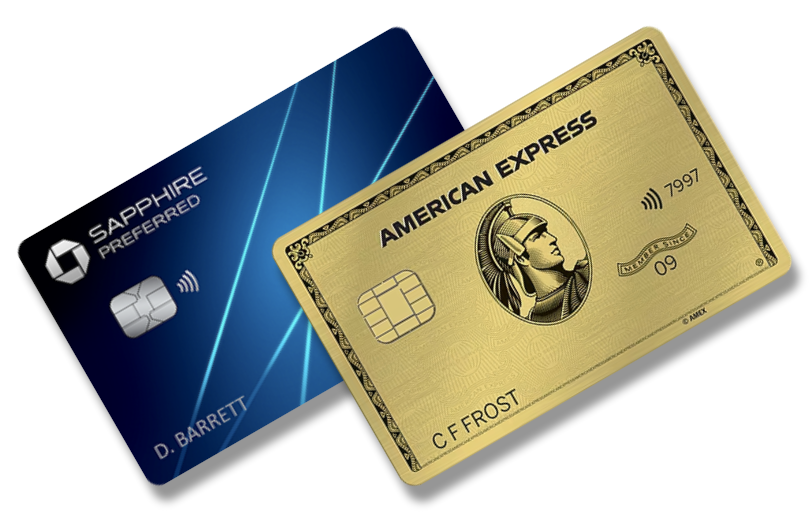Chase Sapphire Preferred vs. American Express Gold: Which Card is Better in 2025?
The Chase Sapphire Preferred and the American Express Gold cards are two of the most popular credit cards for dining and travel rewards
When it comes to credit card rewards, there are two heavyweights that often take center stage:
The Chase Sapphire Preferred and the American Express Gold.
Both of these cards are notorious for their generous benefits and impressive perks, and have amassed massive followings of travel and dining enthusiasts. However, as both of these credit cards have overlapping benefits and operate in completely different reward ecosystems, it may not make sense to have both in your wallet. While there are ways for you to combine your American Express Membership Rewards and your Chase Ultimate Rewards, it is generally more efficient to use a selection of cards within one ecosystem to get the most value from your points.
Related: The 3 Best Credit Card Trifectas
With both the Sapphire Preferred and the AmEx Gold, you can expect a generous sign-on bonus, great point earning, and useful travel partners. Clearly, both of these cards are excellent, but which truly offers more value for your lifestyle and spending habits?
To help you answer that question, we have leveraged our vast personal experience with the credit card market to compare these two titans of the industry, exploring their features, rewards, and downsides. Whether you're a frequent traveler seeking to maximize your points or a foodie looking to earn rewards on dining, we'll provide you with an in-depth analysis to help you determine which card is a better fit.
Both of these credit cards can help you earn points to go on the vacation of your dreams (like to Park Hyatt Kyoto)!
By the end of this comparison, you'll have a comprehensive understanding of the key differences between the Chase Sapphire Preferred and the American Express Gold, empowering you to make an informed decision on which credit card makes more sense for you!
Now with that background out of the way, let’s start by exploring the two cards individually.
The Chase Sapphire Preferred (CSP) is probably the most popular travel credit card on the market today. While some may oversell how useful it is for everyone, there’s a reason that the Sapphire Preferred is one of the most coveted Chase credit cards and is recommended by every YouTuber, blog, and website out there: it offers great rewards that are cheap to earn and simple to use.
Let’s start by reviewing the basics of the Chase Sapphire Preferred.
Annual Fee: $95
Sign-On Bonus: 60,000 Ultimate Rewards Points after spending $4,000 in 3 months (though historically this has gone as high as 100,000 points)
Reward Earning: 5x points on travel booked through the Chase travel portal, 3x points on dining, takeaway/delivery, select streaming services, and online grocery delivery, 2x points on all travel (e.g., flights, trains, hotels, etc.), and 1x points on everything else
Other Benefits: $50 annual hotel credit, complimentary DoorDash DashPass, extra 10% point bonus on each card anniversary
As you can see, the Chase Sapphire Preferred is built around giving you rewards on your dining and travel. The addition of the $50 hotel credit makes the effective annual fee only $45—if you then spend $15,000 a year on dining, food delivery, and travel (combined), you’re already guaranteed to get a net positive value out of holding the card.
The basics of the Chase Sapphire Preferred credit card
While we do not recommend booking reward trips through travel portals, the additional 1.25x value you get for your points when redeeming through the Chase Travel Portal can go a long way with any expensive point redemptions. We always recommend checking the portal prices before booking any flights or hotel stays, even if it is rarely how we book our reward redemptions.
However, the biggest benefit of having a Chase travel card is the valuable travel partners you gain access to—particularly, United, Southwest, and most notably, Hyatt.
If all you do with your Chase Ultimate Rewards points is transfer them directly to Hyatt and book hotel stays, you can consistently get value upwards of 2+ cents per point from all your redemptions! As Hyatt has a plethora of incredible properties across the globe that can almost all be booked for fixed rates with points, booking with Hyatt is one of the most simple and effective ways to use your credit card points.
Luckily, Chase also has a variety of other partners as well—see below for the full list of Chase travel transfer partners:
The full list of travel transfer partners with Chase Bank
The Chase Sapphire is overall one of the most popular credit cards on the market due to its effective simplicity. You don’t need to be a credit card pro to get great value from the CSP; as long as you use the card consistently for your dining and travel, you’ll likely make enough back in points to make the already-small annual fee effectively $0. Plus, the card offers several passive benefits (e.g., rental car insurance, no foreign transaction fees, trip insurance, etc.) that help to provide peace of mind for big purchases.
While it’s disappointing that the CSP doesn’t have any bonus points for in-person grocery purchases, that is arguably the only major fault that the card has, and most people will benefit from holding this card.
The American Express Gold is AmEx’s direct competitor to the Chase Sapphire Preferred. Unlike the more expensive American Express Platinum which focuses exclusively on travel, the Gold offers a healthy mix of both food and travel benefits for a lower annual fee. As these spending categories are often among people’s highest, it is clear why the Gold card is so attractive.
Let’s go over the basics of the American Express Gold:
Annual Fee: $325
Sign-On Bonus: 75,000 Membership Rewards points when you spend $4,000 in 6 months (but this has been as high as 100,000 points)
Reward Earning: 4x points on all things food (dining, takeaway/delivery, groceries), 3x points on flights, and 1x points on everything else
Other Benefits: $120 dining credit at select restaurants, $120 Uber credit ($10 monthly), $100 Resy credit, $84 Dunkin credit, $100 AmEx Travel hotel credit
The AmEx Gold is a fascinating credit card. It offers almost all the same spending reward categories as the CSP (except giving bonus points for just flights instead of all travel), but gives more points per dollar for spending on dining, takeaway/delivery, and flights, with the addition of bonus rewards for groceries.
However, the Gold also costs $230 more than the CSP every year. The card’s various credits can bring the effective annual fee down to $0, through only holds for cardholders who use the credits every month. If you’re already using Uber/UberEats and dining at any of the included restaurants (ShakeShack, Cheesecake Factory, Dunkin, etc.), then this card is a no-brainer for you to add to your wallet.
Recommended Article: The Complete American Express Card Tier List
On the other hand, if you don’t already use any of these services/dine at any of these places, you’re going to have to rely on points-earning to get value from the card. In order to earn at least $325 worth of points each year, you would have to spend a minimum of $8,200 on food, $11,000 on flights, or a mix of the two (e.g., $7,500 on food and $1,000 on flights).
Similar to Chase, American Express offers a wide range of travel partners for transferring your points. Some of the most notable AmEx transfer partners are Delta, Hilton, and ANA, all of which can provide exceptional value for your points (though the value of Hilton rewards is a significant step down from Hyatt). See below for the full list of American Express transfer partners:
The complete list of transfer partners from American Express
Overall, the American Express Gold card is an elite option for helping you earn points on your food and travel spending. While American Express Membership Rewards points are slightly more complex to use than Chase Ultimate Rewards points, it is still very easy to find great redemptions and value for your AmEx points, especially when transferring to airline partners.
However, it’s important to note that the Gold card can pose some issues if you frequently travel internationally. Firstly, many of the card’s benefits are only applicable if you’re in the USA, including the 4x points on groceries and takeout/delivery, as well as the $120 Uber credit—all of these benefits aren’t valid outside of the USA.
Suggested Article: American Express Gold vs. Capital One Venture X
As well, American Express continues to relatively low acceptance internationally compared to VISA cards. While AmEx has done a lot in the past 10 years to improve its card acceptance, it remains a gamble whether where you’re traveling will accept your American Express card for your purchases.
While these aren’t necessarily dealbreakers for the credit card, they can be big issues for certain individuals.
Which card makes more sense for you?
Both of these cards can provide exceptional value!
Both the American Express Gold and the Chase Sapphire Preferred are excellent credit cards, and deciding between them can be extremely difficult. However, you do not have to make a choice; for many individuals, having both the Chase Sapphire Preferred and the American Express Gold can provide extra benefits.
To start, there are several shared transfer partners between Chase and AmEx, which allow you to effectively combine your Chase and AmEx points for a single booking! These cards’ spending reward categories also fit together nicely—we use both of these cards and find that we are able to accumulate AmEx and Chase points easily—just use the Gold for flights and groceries, and the CSP for dining and other travel. That’s it.
Related Article: The Capital One Credit Card Trifecta
However, if you can only have just one of these cards (maybe you’re conscious of annual fees, or are getting close to Chase’s 5/24 rule), then follow this basic pathway for making a decision between the two:
1. Decide if there is a particular travel partner that you’re interested in using, and then choose the card that gives you access to that partner. At the end of the day, rewards are only valuable if you’re able to use them the way you want. For instance, if you’re set on using your points to stay at Hyatt, the AmEx Gold isn’t going to give you anywhere near as much value as the Sapphire Preferred. If there isn’t a particular partner you’re interested in using, or the partner is shared between banks, go to the next step.
2. Make a list of the cash-saving credits that each card provides and subtract them from the annual fee—whichever card comes out to a lower value is likely the better card for you! However, it is extremely important that you only include the benefits you know you would use, not the ones you like but don’t have an easy way to take advantage of. See below for a hypothetical example if you used just the two AmEx food credits and the $50 Chase hotel credit.
An example of the calculation for figuring out how much the credits impact a card’s annual fee. Make sure to only include the credits that you will consistently use!
However, if the net price comes out similar or you don’t plan on using these credits, go to the next step in our chart.
3. Look at your spending from the past year and see which of the following conditions fits your spending history better:
If Groceries and Flights were two of your top areas of spending, the American Express Gold card is going to return you more points.
If Dining and Other Travel (e.g., Uber, trains, car rentals, etc.) were two of your top spending areas, the Chase Sapphire Preferred is going to be better for you.
If you still don’t have a clear winner after all three of these steps, we recommend starting with the Chase Sapphire Preferred. While both cards can give you exceptional value for your spending, the CSP is slightly simpler to redeem your points for good value.
However, at the end of the day, both of these credit cards have huge followings because they are exceptional options for both beginners and credit card pros alike, and frankly, you can’t go wrong with either.
We hope this article was helpful to you in your credit card journey! If you’re interested in how these cards stack up against other popular cards on the market, check out our comparisons of the AmEx Gold vs. the Delta SkyMiles Gold and the Chase Sapphire Preferred vs. the Bilt Rewards Mastercard. Plus, if you’re interested in combining points across other ecosystems, make sure to check out our guides for combining Chase and Capital One points, and combining AmEx and Capital One points!
Recommended Articles













